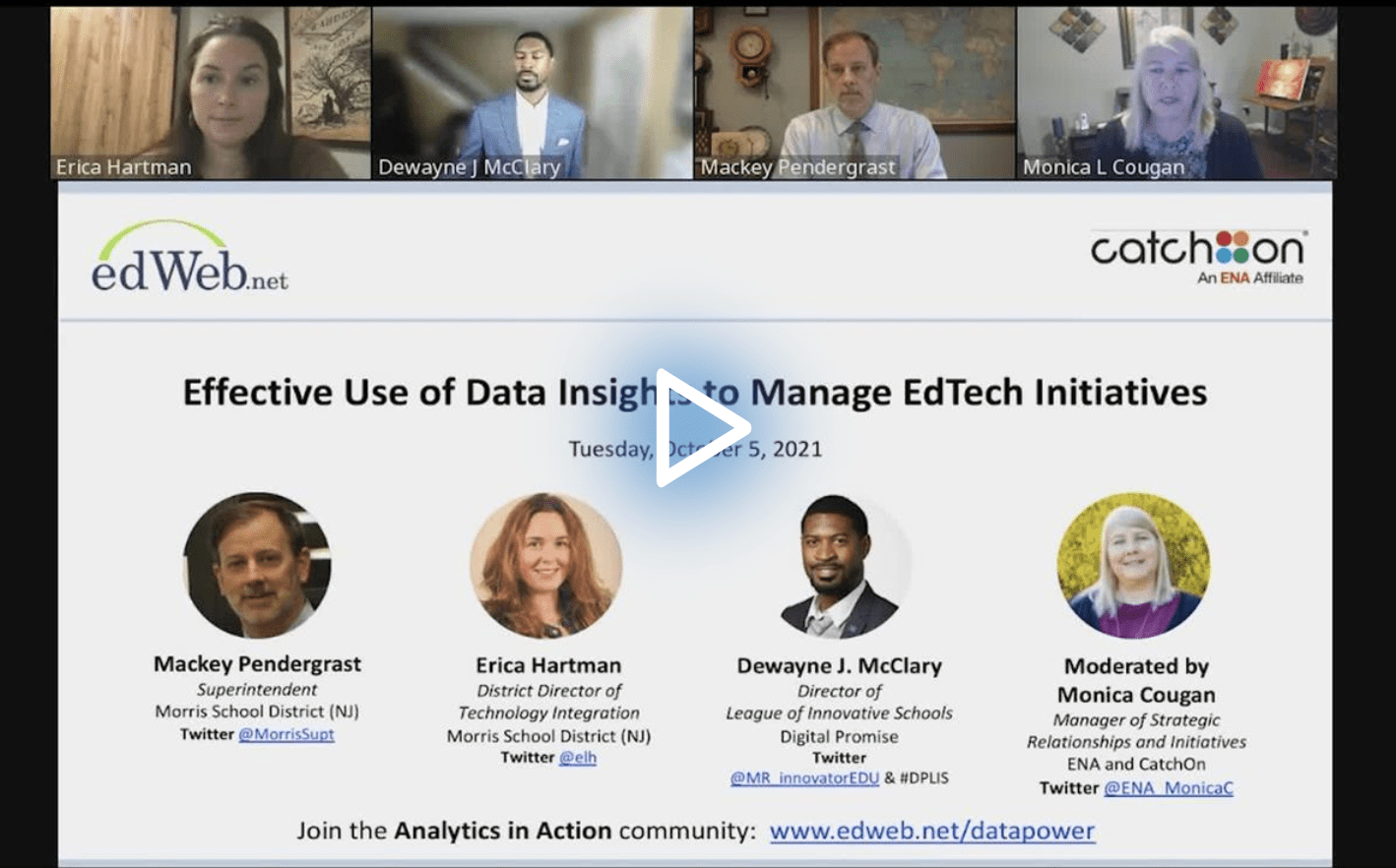Using Data to Improve Student Outcomes and School District Management
Blog post by Robert Low based on this edLeader Panel
While educators and school district administrators have grown used to reviewing assessment results and other forms of student data, they may not yet be looking at newer and increasingly important metrics such as online engagement, trending use of apps, and the return on investments in software.
The value of having a comprehensive data-management system for a school district was discussed during a recent edLeader Panel, sponsored by CatchOn, An ENA Affiliate. The Panel featured Mackey Pendergrast, Superintendent of the Morris School District (NJ), Erica Hartman, District Director of Technology Integration for the Morris School District (NJ), and Dewayne J. McClary, Director of the League of Innovative Schools at Digital Promise.
Dewayne McClary emphasized the crucial role that data can play in documenting the effectiveness of a district’s curriculum and instruction, as well as identifying gaps and inequities, while also providing transparency that builds trust and support throughout the district and its local community.
Districtwide Data Management
McClary also identified the four key components of effective data management—data collection, analysis, interpretation, and sharing—and he noted that districts may be data rich but lack the systems for implementing all four components in a coordinated and effective way.
Erica Hartman confirmed that planning and implementation are essential for a districtwide data-management system that includes all stakeholders, and especially for teachers who play key roles in compiling student data and using it to inform and improve their instruction. She noted that in her district, the technology and curriculum departments are not separate silos, but work together as a team.
Mackey Pendergrast described this process as a combination of “plumbing and poetry,” with the district’s technology infrastructure serving as the plumbing, and the poetry being comprised of teaching and learning, which these days increasingly includes the use of computers and online access. As a result, the money being spent on computer programs and platforms needs to be managed, analyzed, and shared in regard to district finances and its impact on student performance.
The Morris School District now uses a 22-point rubric to evaluate the platforms that its staff and students use, and there is an “upward flow” of data that supports coordinated usage and the sharing of information with the central office, school board, and other stakeholders. Previously, each school in the district had its own platforms, many of which “didn’t talk to each other,” and the district could not provide effective tech support and related professional learning for many of the end users.
Remote learning during the pandemic increased the importance and accelerated the process of managing tech data and other forms of information effectively. Current examples from the Morris School District include a chart showing how many students are logging in from home or school at different times of day, how much is being spent per pupil on platforms, and how much each platform is being used.
This sort of data has helped the district decide which licenses to renew or allow to expire, and has identified the need to provide tech support outside of regular school hours. With so many students logging on after school, the district is looking at the possibility of providing 24/7 online tutoring, based in part on a successful initiative by high school juniors and seniors, who provided support for younger students during the pandemic.
Data Analysis and Interpretation
As Pendergrast pointed out, technology usage is not always the same as engagement, so administrators and educators need to know which tools are being used effectively. This requires a deeper look at how programs and platforms are being used and how that usage correlates with student achievement. Hartman explained that they now provide an “overlay” of usage data in relation to achievement test statistics, College Board scores, and longitudinal studies.
In addition, for end-user interpretation and professional learning, the district now arranges “data walks” in which people walk around a room in which large charts are displayed and share their perspectives on what the data shows and means. This type of approach is supported by a districtwide culture in which looking at data and asking questions are celebrated, with the understanding that many educators do not have a background in statistical analysis but can provide important perspectives based on their roles.
Pendergrast also emphasized the importance of the “democratization of data,” which includes putting information in formats that make it understandable and actionable for different stakeholders. This process can help educators and administrators determine whether the “mental model of what should be happening” matches the actual reality of what is happening in the district.
McClary noted the importance of these types of processes in creating a districtwide culture of change, which starts with identifying where the students are and what needs to improve. This can be a crucial part of helping a district provide more equitable outcomes, and then sharing successful processes and results with other districts.
This edWeb broadcast was sponsored by CatchOn, An ENA Affiliate.
Watch the Recording Listen to the Podcast
About the Presenters
Mackey Pendergrast is the current superintendent of the Morris School District in New Jersey. He began his public school teaching career as a high school history teacher and basketball coach for the Summit Public Schools and held positions in central office administration for the Westfield Public School District and the West Morris Regional High School District before becoming superintendent of West Morris.
In 2014, Mr. Pendergrast participated in the U.S. Department of Education’s Superintendents Technical Working Group, which contributed ideas in the creation of the Future Ready Pledge as well as shaped the agenda for the White House ConnectED to the Future Convening for educational leaders in digital learning, in which he also participated. Along with 11 other superintendents, he contributed to the Obama administration’s National Education Technology Plan.
Mr. Pendergrast has a Master of Arts degree in Educational Administration and a Master of Arts in Education/Counseling. He was adjunct professor in the Teacher Education program at Drew University, where he taught a graduate-level course in Educational Theory and Practice. Mr. Pendergrast was named 2020 Superintendent of the Year for the State of New Jersey by the NJ Association of School Administrators (NJASA).
An avid reader and nature enthusiast, Mr. Pendergrast enjoys swimming and hiking with his wife, also an educator, and their two sons.
Erica Hartman is a technology integration consultant and the District Director of Technology Integration for the Morris School District, a PreK-12 1:1 Chromebook Google Apps for Education district in Morristown, New Jersey. She specializes in data interoperability, digital citizenship, blended learning, 1:1 device implementation, and helping school districts choose digital platforms that best suit their strategic goals and stakeholders. Erica lives in Mendham, New Jersey with her husband, two daughters and a rescue dog. When not online she can be found in the stands cheering on her daughters at their basketball games.
Dewayne McClary comes to Digital Promise most recently as Director of Educational Technology and Library Programs at D.C. Public Schools, where he supervised DCPS’s 1:1 pilot and roll-out and other innovation initiatives. He has broad and deep experience as a teacher and district leader. He has worked in rural South Carolina, the suburbs of Virginia, and at an urban D.C. school district. Dewayne is a visionary and strategic leader, an extraordinary relationship builder, and a highly energetic, adept communicator. In his role as League of Innovative Schools Director, he will lead efforts to increase engagement and impact for the network.
Dewayne earned a B.S. in Political Science from Francis Marion University, an Executive Master’s in Leadership from Georgetown University, and is pursuing a Ph.D. in Curriculum and Instruction from Liberty University.
About the Moderator
Monica Cougan is the manager of strategic relationships and initiatives at ENA and CatchOn, where she leverages her more than 35 years of experience in education and technology to help schools make the most of new technology. Throughout her career, Monica has been an evangelist for the adoption of technology as a transformative educational tool. She also has extensive experience helping K-12 schools implement 1:1 programs and in disseminating problem-based and project-based learning methodologies that focus on helping each student develop his or her own voice. Throughout Monica’s extensive career, she has sought out the diverse experiences required to know how to implement positive changes in education: she has served as a classroom teacher, adjunct professor, and education consultant for national, technology-based curriculum companies. Away from the classroom, she has served as an independent math consultant, worked in curriculum development, evaluated research on school-based programs, and developed professional learning opportunities for educators looking for a new mastery of technology.
Join the Community
Analytics in Action is a free professional learning community on edWeb.net for school technology leaders, superintendents, curriculum and instructional leaders.
CatchOn is a user-friendly data analytics tool that collects real-time data on every device, enabling school districts to make data-informed decisions about the apps and online tools their educators and students are using. In 2018, CatchOn joined forces with ENA, a leading provider of comprehensive technology solutions to education institutions and libraries across the nation. Collectively, CatchOn and ENA leverage their respective resources and expertise to deliver critical services and solutions that help school districts produce positive outcomes in the communities they serve.






Comments are closed.